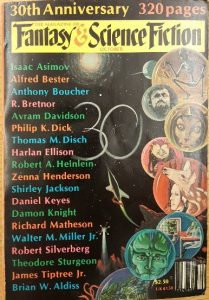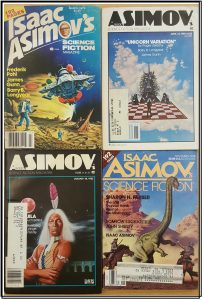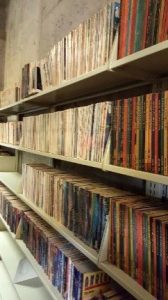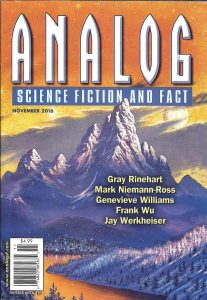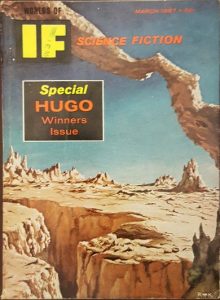[Posted by Ashley Esposito, a graduate student in American Studies doing an internship in the Watkinson]
 As progress continues on this collection, I have switched gears. Individual cleaning and air drying of each volume has proven to be a time consuming endeavor.
As progress continues on this collection, I have switched gears. Individual cleaning and air drying of each volume has proven to be a time consuming endeavor.
This gear change allowed me to plow through five bankers’ boxes of materials in the same time I was able to work on two boxes. With the extra time I was able to focus on the categorizing and sequencing the numerous volumes. Occasionally a duplicate volume was located and the even rarer third copy of a volume.
One unexpected find that I found very interesting was the way that some volumes were marked for postal delivery. In more recent titles the practice of placing the addressee label directly on the magazine publication seems to have become more common. However, I found a few that were still in their original brown paper postal wrapping. According to the US Postal Service at about.usps.com under their Postage Rates for Periodicals: A Narrative History page, periodicals were given a very low rate in the interest of free press that was supported by both Thomas Jefferson and George Washington. This explains the second class marking that seems to have gone out of existence in the modern postage rate schedule.
For me it is easy to see why this collection will appeal to a diverse group of researchers. A researcher could easily look at the printing/binding process of mass publications over the course of many years or the advertisements that find their way into the different magazines or the correlation between pop culture and science fiction predictions. No matter which lens you use, this collection provides a phenomenal look into the past.
[A WEEK LATER]
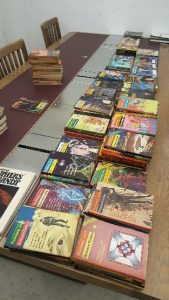 This amazing collection has begun to take shape. This week saw huge strides in the organization and chronological order of this overwhelming set of science fiction magazines. To accomplish this task, it was necessary to sort the magazines by title then by decade, year, then finally by calendar year. It was absolutely amazing to see such a diverse set of images and see the progression of each magazine over the years.
This amazing collection has begun to take shape. This week saw huge strides in the organization and chronological order of this overwhelming set of science fiction magazines. To accomplish this task, it was necessary to sort the magazines by title then by decade, year, then finally by calendar year. It was absolutely amazing to see such a diverse set of images and see the progression of each magazine over the years.
Thus far the majority of the magazines are from the following publications; Analog/Astounding Science Fiction, Galaxy, The Magazine of Fantasy & Science Fiction, and Worlds of If Science Fiction. Analog/Astounding Science Fiction now commonly called ASF has been in publication since the 1930’s. Astounding Science Fiction was combined with Analog in the 1960’s and is publishing.
Galaxy was published from the 1950s-1995 in paper and is now in digital format. The Magazine of Fantasy & Science Fiction began its publications about 1949 and is still in publication. Worlds of If Science Fiction also began its publications about 1949 and is still published.
If you are interested in the ins and outs of the publication dates and history of the magazines, I found lots of information from www.sf-encyclopedia.com to be very enlightening. Approximately fifteen to twenty percent of the collection still needs to be sorted but for now it is on display in the atrium of the Raether LITC, near the circulation desk (Level A). Feel free to stop by and look at the wonder that is this remarkable collection.


 Leigh Couch Collection in progress…
Leigh Couch Collection in progress…